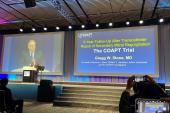Real-world MitraClip Impact in Secondary MR: Reassuring for Some, Not All
In practice, patients are a little sicker and are not receiving GDMT, which is a problem, believes one HF expert.

A new, large postapproval study provides reassurances that transcatheter edge-to-edge repair (TEER) is helpful in secondary mitral regurgitation (MR), and also shows that patients getting clipped aren’t necessarily similar to those treated in the pivotal trials.
In an analysis of 5,000 patients in the COAPT Post-Approval Study (PAS), treatment with MitraClip (Abbott) led to a durable reduction in MR at 1 year and large improvements in quality of life, including among patients who met the inclusion/exclusion criteria for COAPT and MITRA-FR, the two conflicting randomized trials in secondary MR.
“We were impressed when we saw the data,” lead investigator Kashish Goel, MD (Vanderbilt University Medical Center, Nashville, TN), told TCTMD. “It’s an all-comers population at 406 sites and their outcomes were excellent.” In Goel’s opinion, however, this study population differs substantially from those in the randomized trials done to date. “When we looked at how many patients would meet the COAPT or MITRA-FR criteria, it was only about 20%,” said Goel.
Patients in COAPT-PAS had more comorbidities, more severe heart failure, and more functional limitations than those treated in COAPT and MITRA-FR, Goel said. They were also less likely to be treated with guideline-directed medical therapy (GDMT) before undergoing the MitraClip procedure.
“It is a sicker population,” said Goel. “You’d expect that from a real-world study. Even the severity of site-reported MR was higher in our study, with about 75% of patients having severe MR compared with 50% in COAPT.”
But Gregg Stone, MD (Icahn School of Medicine at Mount Sinai, New York, NY), lead investigator for COAPT, wasn’t convinced this cohort was markedly sicker than those treated in the randomized trials. He noted that sites tend to overestimate MR severity and LVEF, adding that the site-reported LVEF in the postapproval study was 37.0%, higher than the 31.3% documented by the core laboratory in COAPT. As for greater MR severity in COAPT-PAS, Stone said this isn’t reflected by effective regurgitant orifice area (EROA) data, which were equivalent in COAPT and COAPT-PAS.
“The ventricles were substantially less dilated, the ejection fraction was substantially higher, and the EROAs were the same,” said Stone. “The latter finding suggests that the severity of mitral regurgitation was similar. The patients were somewhat older by about a year, there was a higher incidence of women, and there were some other changes in baseline demographics. So, there’s some elements in the PAS study that pointed to the patients being at slightly higher risk and other elements that were definitely lower risk.”
Nathan Mewton, MD, PhD (Hôpital Cardiovasculaire Louis Pradel, Lyon, France), senior investigator of MITRA-FR, pointed to other aspects of these new data that muddy the waters. Nearly half of patients treated as part of this postapproval study have features of primary MR, with 48.8% having evidence of mitral annular calcification, which was absent in COAPT and MITRA-FR. Moreover, there was no adjudication committee to truly distinguish primary from secondary MR among the COAPT-PAS cohort.
“For me, at least 50% of them are primary MR patients, so the data are not comparable” to COAPT and MITRA-FR, said Mewton. “You’re comparing two different diseases. . . . The registry is really comparing apricots to pears.”
In an editorial, Mathias Orban, MD, and Jörg Hausleiter, MD (Medizinische Klinik und Poliklinik I, Klinikum der Universität München, Munich, Germany), agree that the COAPT and MITRA-FR populations enrolled different patients than this postapproval study, but that doesn’t change the fact that these new data show that TEER effectively reduces MR and is associated with improved outcomes outside randomized trials.
“Transcatheter edge-to-edge therapy for secondary MR is now a guideline-recommended therapeutic option for heart failure patients with secondary MR, but many more questions remain to be answered to accompany the successful expansion of mitral-TEER in real-world daily practice and to further optimize outcomes in this vulnerable patient population,” they write.
The new study and editorial were published online ahead of the September 26, 2023, issue of the Journal of the American College of Cardiology.
Real-world TEER
Both COAPT and MITRA-FR, testing the MitraClip in patients with heart failure and severe functional mitral regurgitation, were published in 2018. COAPT, in 614 patients, showed that TEER reduced the risk of heart failure hospitalizations, the study’s primary endpoint, as well as mortality at 2 years. MITRA-FR, by contrast, found no difference in the rate of the deaths/heart failure hospitalizations among 304 patients treated with either the MitraClip or best medical care. This discrepancy led to significant debate among researchers and specialists attempting to explain the conflicting results, with some suggesting it could be due to differences in baseline characteristics or background medication use.
On the basis of COAPT, TEER received an expanded US Food and Drug Administration indication and is now has a class 2a (level of evidence B) recommendation in the US for patients with severe secondary MR and persistent symptoms despite being treated with optimal GDMT. In Europe, TEER is recommended only for advanced HF patients with secondary MR not suitable for surgery (class 2a).
In COAPT-PAS, investigators assessed the safety and effectiveness of MitraClip in patients with secondary MR treated at US centers participating in the Society of Thoracic Surgeons/American College of Cardiology Transcatheter Valve Therapy (STS/ACC TVT) registry. Patients had a high burden of comorbidities, including 35% with diabetes, 86% with hypertension, 38% with a prior MI, and 61% with atrial fibrillation/flutter. Nearly two-thirds had at least one HF hospitalization in the year prior to TEER and 86% had NYHA class III/IV symptoms. Nearly 40% had mixed etiology (both primary and secondary MR were checked on the registry collection form).
Approximately one-third of the full COAPT-PAS cohort died or were hospitalized for HF at 1 year. Individually, all-cause mortality and HF hospitalization rates were 22.2% and 18.9%.
Zeroing in on the patients who would have met the COAPT inclusion/exclusion criteria, all-cause mortality/HF hospitalization occurred in 30.8% of the 991 patients, while the rates of all-cause mortality and HF hospitalization, individually, were 17.0% and 19.7%. Those event rates are similar to those of TEER-treated patients in the COAPT trial and significantly lower than those of patients who received GDMT in the randomized trial.
In all, 917 postapproval study patients met the MITRA-FR criteria, and of these patients, 43.6% died or were hospitalized for HF at 1 year. The rate of all-cause mortality alone was 25.7%, while the rate of hospitalization for HF was 28.7%. Here, the combined endpoint of all-cause mortality/HF hospitalization was numerically lower than that observed in the MITRA-FR randomized trial (43.6% vs 54.6%), a difference driven by a larger observed reduction in HF hospitalizations (28.7% among MITRA-FR-like patients vs 48.7% in MITRA-FR).
The clip implantation rate was 97.7% and a reduction of MR to less than 2+ was observed in 90.7% of the full cohort (MR ≤ 2+ in 89.7% of the COAPT-like patients and in 86.6% of the MITRA-FR-like patients). The Kansas City Cardiomyopathy Questionnaire (KCCQ) scores also improved significantly from baseline, up 29 points in the overall COAPT-PAS, 27 points in COAPT-like patients, and 33 points in the MITRA-FR-like cohort.
What About GDMT?
To TCTMD, Goel said comparisons between COAPT-PAS and COAPT are based on individual patient-level data, as they had access to the Abbott datasets. The researchers did not have the same access to MITRA-FR data, such that all comparisons were done using publicly reported data. Overall, the MITRA-FR-like patients were slightly sicker than the COAPT-like patients, said Goel, noting they had lower baseline LVEF and all had a prior hospitalization in the past year as part of the inclusion criteria.
“They had more risk factors, more MR, slightly more dilated LVs, and the outcomes are worse than the COAPT-like patients,” he said. “But what this study shows is that even [MITRA-FR] patients would benefit from the intervention because heart failure hospitalizations were still lower than what has been reported in the trials,” said Goel. “They still had a significant improvement in KCCQ scores and NYHA symptoms.”
The registry is really comparing apricots to pears. Nathan Mewton
As for real-world patients being less likely to be treated with optimal GDMT, Goel said it’s often because they don’t do well with maximally tolerated dosages.
“Also, sometimes there is a lower threshold to treat [with TEER] if the patient is symptomatic, even if they aren’t on full GDMT,” he said. “I think this reflects the real world, how people practice. There is room for improvement.” It’s also possible, said Goel, that improving background medical therapy could have lowered event rates further.
Mewton pointed out that in COAPT-PAS, only 83.2% of patients were treated with diuretics, while use of ACE inhibitors/ARBs and angiotensin receptor-neprilysin inhibitors was “immensely low” at 48.2% and 9.7%, respectively. Sodium-glucose cotransporter 2 (SGLT2) inhibitors—which have been “game changers” in HF, said Mewton—were not used because postapproval study patients were treated between 2019 and 2020, before SGLT2 inhibitors were indicated for HF.
For Mewton, MitraClip “serves potentially as an excuse for heart failure specialists not to treat properly with guideline-directed medical therapy.”
While GDMT can have a massive effect on blood pressure, Mewton believes that among GDMT-naïve HF patients with a dilated left ventricle and significant MR, “you won’t talk about mitral regurgitation anymore in 99% of the cases afterwards” if they are properly decongested and treated carefully with the four pillars of HF therapy. Mewton believes another trial with MitraClip in secondary MR is warranted, especially given the different outcomes between COAPT and MITRA-FR. That trial would also need to ensure that all HF patients were optimized on GDMT, including SGLT2 inhibitors, he said.
Cautious Interpreting Outcomes Data
Real-world data has limitations, Stone said: the postapproval study includes just 1 year of follow-up in little more than half of the 5,000 patients (53.1%). All the same, he continued, these data cement a role for TEER in secondary MR, outside of clinical trials.
“It does appear as if there’s a high success rate in the real world and that it’s a safe procedure,” said Stone.
He urged caution interpreting the site-adjudicated results of this study.
“To compare site-reported clinical outcomes from the COAPT-PAS to CEC-adjudicated event data from COAPT is problematic, especially for heart failure hospitalizations, which require a specific set of criteria that the CEC pours over,” he said. “I’m more confident in the comparative results for all-cause mortality.”
In COAPT, though, it was 2 years before the mortality benefits of TEER were evident and statistically significant. As such, a cross-study comparison between COAPT and a postapproval study with limited follow-up is a challenge to interpret. Moreover, comparing clinical outcomes in the postapproval study with COAPT without multivariable adjustments accounting for ventricular function, MR severity, and comorbidities is problematic, said Stone.
The improvements in quality of life, though, are reassuring, he said. Overall, there was a large gain in the KCCQ from baseline, “a marked improvement which does suggest these patients are benefitting from TEER,” said Stone.
Mewton wasn’t convinced, saying he’s skeptical of these improvements, which could easily reflect a placebo effect among patients treated in this real-world setting.
Michael O’Riordan is the Managing Editor for TCTMD. He completed his undergraduate degrees at Queen’s University in Kingston, ON, and…
Read Full BioSources
Goel K, Lindenfeld J, Makkar R, et al. Transcatheter edge-to-edge repair in 5,000 patients with secondary mitral regurgitation: COAPT post-approval study. J Am Coll Cardiol. 2023;82:1281-1297.
Orban M, Hausleiter J. Expanding success of mitral transcatheter edge-to-edge repair in real-world patients: and more questions to answer. J Am Coll Cardiol. 2023;82:1298-1300.
Disclosures
- The COAPT-PAS was supported by Abbott.
- Goel reports consulting/proctoring for Edwards Lifesciences and consulting for Abbott.
- Hausleiter reports research support from Abbott Vascular.
- Mewton reports no relevant conflicts of interest.
- Stone reports research grants from Abbott, Abiomed, Bioventrix, Cardiovascular Systems Inc, Philips, Biosense Webster, Shockwave, Vascular Dynamics, Pulnovo, V-wave; consulting/royalties/owner stockholder of Abbott, Daiichi Sankyo, Ablative Solutions, Robocath, Miracor, Vectorious, Valfix, Therox, HeartFlow, Neovasc, Ancora, Elucid Bio, Occlutech, Impulse Dynamics, Adona Medical, Millennia Biopharma, Oxitope, Cardiac Success, HighLife, Cagent, Applied Therapeutics, Biostar family of funds, SpectraWave, Orchestra Biomed, Aria, and Xenter; and speakers’ honoraria from Medtronic, Abiomed, and Boehringer Ingelheim.





Comments